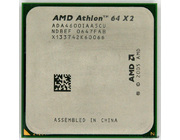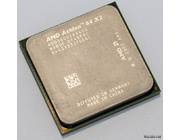AMD launched the 6000+ in February 2007. At that time it was the fastest that AMD had to offer against the Core 2 Duo. Intel still had the fastest product but the 6000+ did offer a fair bit of competition. But, in the end I guess that the 6000+ didn't sell very well due to the hype of the Core 2 Duo. Especially for enthusiasts (who are the ones that buy high-end stuff mostly) the Core 2 Duo was interesting since it overclocked a lot easier and higher than the Athlon 64 X2 6000+.
Eventually AMD launched the Athlon 64 X2 6400+ Black Edition. After that the Phenom made it's debut as monolithic quad-core CPU marking the official end of the Athlon 64 X2 'K8' product line. > Read more
Introduced in May 2006 together with the models from 3800+ up to 5000+. The release was one month before the release of Intel's Core 2 Duo. This hurt sales since people waited for the Core 2 Duo to arrive and once it did it was clear that the Core 2 Duo was the better choice.
This particular 4600+ was made in the 47th week of 2006. Not a bad CPU in it's time but as said; the Core 2 Duo was the favourite choice being slightly faster, cooler and far more overclockable. > Read more
Just like the 6000+ but clocked 200MHz slower. > Read more
Just like the X2 3600+ but with 512KB L2-cache per core rather than 256KB per core.
The first versions of the X2 3800+ (with Manchester core) were aggressively competed by Intel with the Pentium D 830. Both CPU's were priced in the same ballpark and evenly matched in performance. Especially when the Pentium D 930 (with Presler core) came to marked the choice was even more difficult. Back in the day a lot of people eventually waited for Core 2 Duo to pop up in summer 2006. > Read more
The slowest AMD Athlon 64 X2 in the 'Windsor' family. Basically identical to the X2 3800+ but with half the L2-cache enabled. > Read more




